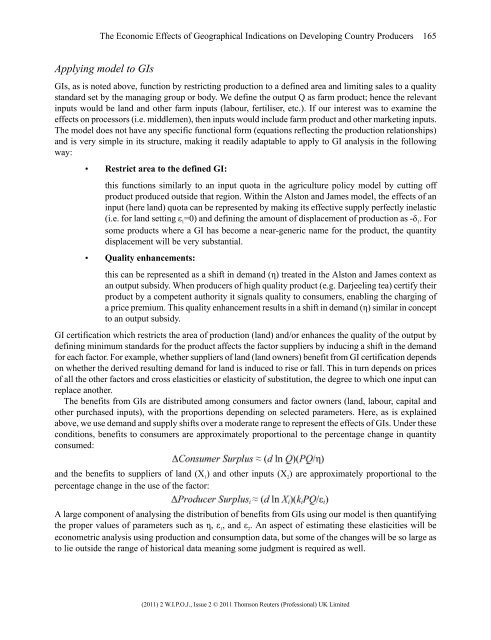WIPO Journal - World Intellectual Property Organization
WIPO Journal - World Intellectual Property Organization
WIPO Journal - World Intellectual Property Organization
Create successful ePaper yourself
Turn your PDF publications into a flip-book with our unique Google optimized e-Paper software.
The Economic Effects of Geographical Indications on Developing Country Producers 165<br />
Applying model to GIs<br />
GIs, as is noted above, function by restricting production to a defined area and limiting sales to a quality<br />
standard set by the managing group or body. We define the output Q as farm product; hence the relevant<br />
inputs would be land and other farm inputs (labour, fertiliser, etc.). If our interest was to examine the<br />
effects on processors (i.e. middlemen), then inputs would include farm product and other marketing inputs.<br />
The model does not have any specific functional form (equations reflecting the production relationships)<br />
and is very simple in its structure, making it readily adaptable to apply to GI analysis in the following<br />
way:<br />
• Restrict area to the defined GI:<br />
this functions similarly to an input quota in the agriculture policy model by cutting off<br />
product produced outside that region. Within the Alston and James model, the effects of an<br />
input (here land) quota can be represented by making its effective supply perfectly inelastic<br />
(i.e. for land setting ε 1=0) and defining the amount of displacement of production as -δ 1. For<br />
some products where a GI has become a near-generic name for the product, the quantity<br />
displacement will be very substantial.<br />
• Quality enhancements:<br />
this can be represented as a shift in demand (η) treated in the Alston and James context as<br />
an output subsidy. When producers of high quality product (e.g. Darjeeling tea) certify their<br />
product by a competent authority it signals quality to consumers, enabling the charging of<br />
a price premium. This quality enhancement results in a shift in demand (η) similar in concept<br />
to an output subsidy.<br />
GI certification which restricts the area of production (land) and/or enhances the quality of the output by<br />
defining minimum standards for the product affects the factor suppliers by inducing a shift in the demand<br />
for each factor. For example, whether suppliers of land (land owners) benefit from GI certification depends<br />
on whether the derived resulting demand for land is induced to rise or fall. This in turn depends on prices<br />
of all the other factors and cross elasticities or elasticity of substitution, the degree to which one input can<br />
replace another.<br />
The benefits from GIs are distributed among consumers and factor owners (land, labour, capital and<br />
other purchased inputs), with the proportions depending on selected parameters. Here, as is explained<br />
above, we use demand and supply shifts over a moderate range to represent the effects of GIs. Under these<br />
conditions, benefits to consumers are approximately proportional to the percentage change in quantity<br />
consumed:<br />
and the benefits to suppliers of land (X 1) and other inputs (X 2) are approximately proportional to the<br />
percentage change in the use of the factor:<br />
A large component of analysing the distribution of benefits from GIs using our model is then quantifying<br />
the proper values of parameters such as η, ε 1, and ε 2. An aspect of estimating these elasticities will be<br />
econometric analysis using production and consumption data, but some of the changes will be so large as<br />
to lie outside the range of historical data meaning some judgment is required as well.<br />
(2011) 2 W.I.P.O.J., Issue 2 © 2011 Thomson Reuters (Professional) UK Limited

















